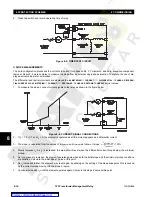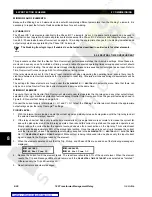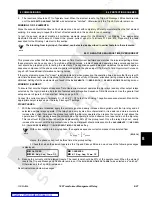
GE Multilin
745 Transformer Management Relay
8-19
8 COMMISSIONING
8.5 PROTECTION SCHEMES
8
A simple verification the selected reset mode can be obtained using Figure 8–9: General Test Setup on page 8–18. The
procedure consists of performing repetitive operating time measurements in quick succession. If the reset is selected for
instantaneous, the operating time will always be equal to the nominal time derived from the selected curve. If the reset is
selected as linear, the operating time will vary as a function of the time between successive application of the current sig-
nal. If performed at current multiples of 2 to 3 times the pickup level, the variations in operating time will be easier to detect.
e) PHASE B AND C ELEMENTS
If the Phase A element performed correctly and met specifications, repeat the Pickup Level portion of the above test for the
B and C phases of Winding 1. For Phase B, X = H2 and Y = G2. For Phase C, X = H3 and Y = G3. The displayed message
should change to indicate the correct phase, winding, and element that operated.
f) WINDING 2 AND 3 ELEMENTS
Because the Winding 2 and 3 elements can be set with completely different parameters than the elements for Winding 1, it
is necessary to repeat the full set of tests described above for each winding.
The blocking from logic input, if enabled, can be tested as described in earlier tests for other elements.
8.5.5 PHASE INSTANTANEOUS OVERCURRENT
a) PHASE IOC 1
This procedure verifies that the Phase IOC performance matches the in-service settings. The settings for these elements
are found under the
S4 ELEMENTS
ÖØ
PHASE OC
setpoints menu. The testing occurs at current multiples of at least five
times the rated CT secondary value.
Do not leave the current signal on for more than a few seconds!
WINDING 1 ELEMENTS:
To ensure that only the Phase Instantaneous Overcurrent 1 element operates the trip relays (and any other output relays)
selected by the logic, disable all protection features except Phase Instantaneous Overcurrent 1. Use the general test setup
shown in Figure 8–9: General Test Setup on page 8–18.
Connect the current supply to terminals X = H1 and Y = G1 to test the Winding 1 Phase A element. Monitor the appropriate
output relays as per the relay FlexLogic™ settings.
PICKUP LEVEL:
1.
With the interval timer disabled, apply the current signal and increase its magnitude until the trip relay (and all selected
auxiliary relays) operate. Compare the measured operating level against the
S4 ELEMENTS
ÖØ
PHASE OC
ÖØ
W1
PHASE INST OC 1
ÖØ
W1 PHASE INST OC 1 PICKUP
setpoint.
2.
Check that Trip, Pickup, and Phase A(C) LEDs turn on when the element operates. Check that one of the following
messages is displayed:
3.
Reduce the current until the element resets. The reset level should be 97% of the operate level. When the element
resets, the Trip and Phase LEDs should remain on if the
W1 PHASE INST OC 1 TARGET
was selected as "Latched". Oth-
erwise, only the Trip LED should stay on.
4.
Reset indicators and clear messages.
OPERATING TIME:
Using the setup shown in Figure 8–9: General Test Setup on page 8–18 and the Interval Timer enabled, set the current
level to 1.5 times the operating level of the element. Apply current suddenly by closing the double-pole switch. Record the
operate time and compare it to the
S4 ELEMENTS
ÖØ
PHASE OC
ÖØ
W1 PHASE INST OC 1
ÖØ
W1 PHASE INST OC 1 DELAY
set-
point value.
PHASE B AND C ELEMENTS:
If the Phase A element performed correctly and met specifications, repeat the Pickup Level portion of the above test for
Phases B and C of Winding 1. For Phase B, X = H2 and Y = G2. For Phase C, X = H3 and Y = G3. The displayed message
should change to indicate the correct phase, winding, and element that operated.
LATCHED a
W1 Phase Inst OC 1
OPERATED a
W1 Phase Inst OC 1
NOTE














































